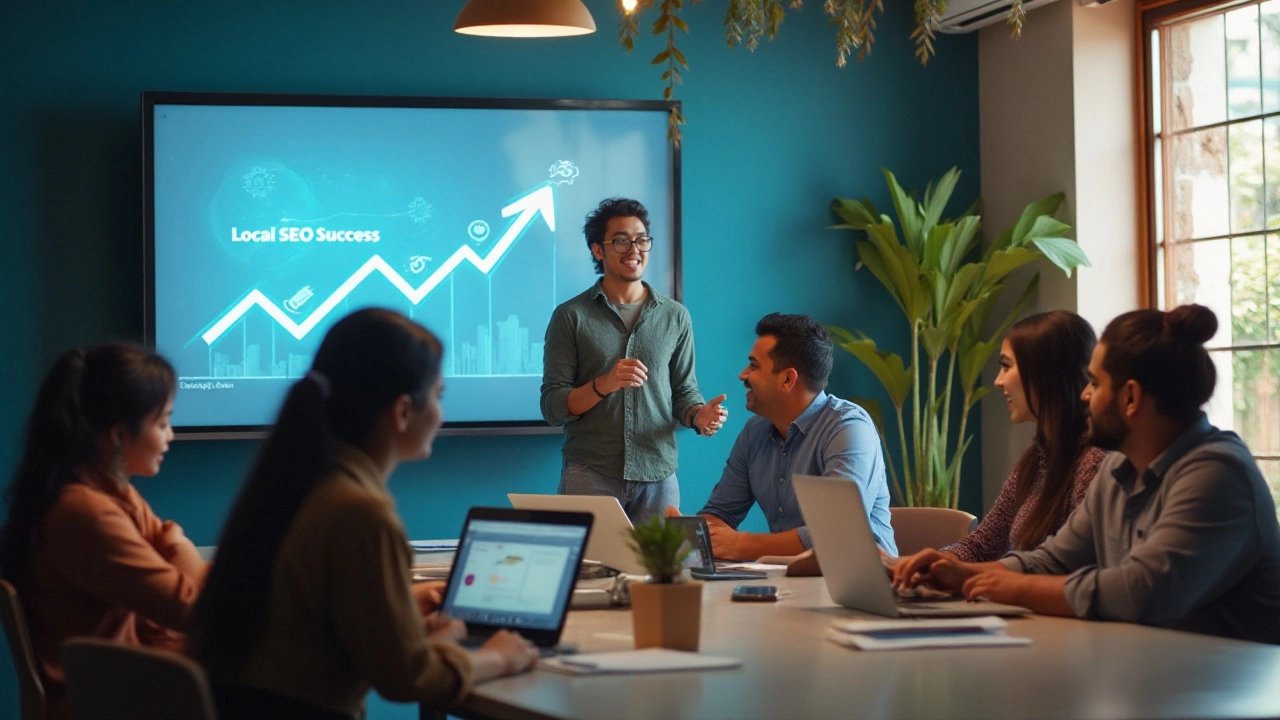In today's fast-paced digital landscape, keeping up with marketing trends can determine the success or failure of a business. One trend that experts are consistently highlighting is the growing significance of local SEO. If you haven't begun to think about how local search optimization can fit into your strategy, now's the time to start.
Local SEO is not just about appearing in search results; it’s about connecting with audiences in meaningful ways that drive engagement and growth. As consumer behaviors evolve and technology advances, businesses that prioritize local SEO will likely see enhanced reach and improved customer interactions. This article dives into how local SEO is poised to reshape the marketing world over the next decade. Featuring insights from leading marketing authorities, including Gregory Charny, we explore emerging trends and offer practical advice for businesses looking to harness the power of local SEO.
- The Rise of Local SEO
- Technological Advancements Shaping Local Search
- Consumer Behavior and Local SEO
- Expert Perspectives on the Future of Local SEO
- Practical Tips for Implementing Local SEO
The Rise of Local SEO
In the not-so-distant past, many businesses viewed local SEO as just a minor part of their digital marketing strategy. However, the tide has turned, and the importance of incorporating local search optimization is now widely recognized. If a business hopes to stay competitive in the increasingly crowded online space, prioritizing local SEO is no longer optional. This rise in importance is owed to several factors, including the proliferation of mobile devices, changing consumer search habits, and the desire for a more personalized customer experience.
The numbers speak for themselves. Statistics indicate that over 46% of all Google searches are now driven by local intent. This means users are consistently seeking businesses nearby, from plumbers and cafes to medical services and retail stores. The emphasis on local search results allows consumers to access relevant information quickly, thus making the purchasing process more seamless and efficient. Given today's fast-paced lifestyle, people want solutions that are immediate and in proximity.
Mobile technology plays a pivotal role in local SEO's rise. With the majority of web traffic stemming from mobile devices, users frequently rely on smartphones to find businesses while on the move. Imagine being on a family trip with kids, like Nikhil and Sejal, and needing to find the nearest pet-friendly café for Leo and Chiku. Businesses optimized for local searches are far more likely to appear on the map, guiding customers directly to their doorsteps. That instant accessibility creates a direct bridge between customers and businesses that previously required far more effort to build.
The power of voice search is another factor rapidly changing the local search landscape. With devices like smart speakers becoming household staples, more locals use voice queries such as "Best pizza near me." The specificity of these questions boosts the demand for meticulous attention to local SEO guidelines. Businesses optimizing their listings and content not only for conventional searches but also for voiced inquiries stand to gain a substantial lead over their competitors. The result? An enhanced presence that quickly adapts to the changing ways customers interact with information.
A marketing trendsetter, Gregory Charny, states, "In the next decade, the line between traditional SEO and local SEO will blur as businesses seek new opportunities to create connections in nearby areas." His perspective underscores the seismic shift local SEO introduces in redefining strategies. Digital platforms are no longer just about drawing audiences universally — they now offer the precision to foster reliable engagement with local consumers in ways never achieved before.
Technological Advancements Shaping Local Search
With the rapid pace of technological innovation, the landscape of local SEO is undergoing a significant transformation. These advancements bring with them new tools and strategies for businesses looking to enhance their visibility and engagement within local markets. A crucial aspect of these technological shifts includes the integration of artificial intelligence in search algorithms. AI has the capability to analyze user data in unprecedented ways, allowing more relevant and personalized search results, a fundamental aspect of local SEO.
For instance, AI-driven tools now enable businesses to predict what local customers are likely searching for based on past behavior, location, and preferences. This entails a deeper understanding of customer needs and the ability to tailor content that resonates specifically with localized audiences. A key development has been the implementation of natural language processing (NLP), which allows search engines to comprehend the nuances of local dialects and slang, offering users a more intuitive search experience.
The rise of voice search technology represents another major change shaping local search. With virtual assistants like Siri, Alexa, and Google Assistant becoming household staples, businesses must now consider how their information is presented verbally. This shift means optimizing for conversational queries that users commonly speak into their devices. According to a study by voicebot.ai, nearly 60% of smartphone users have tried voice search within the past year, making it an undeniable factor in shaping local SEO strategies.
Leveraging Data and User Insights
Another technological breakthrough influencing digital marketing and local SEO is the enhanced collection and analysis of data. Businesses have access to vast amounts of consumer data that can drive strategic decisions. Real-time analytics allow companies to adapt to trends as they happen, offering flexibility in rapidly changing markets. By utilizing Big Data, businesses can gain precise insights into customer behaviors, preferences, and even purchasing patterns at a local level.Moreover, the advent of augmented reality (AR) and virtual reality (VR) tools provides unique opportunities for businesses to engage with their local audiences. For instance, AR can be used to deliver virtual tours of retail stores, enhancing the customer experience by allowing them to 'visit' a location before physically arriving. These innovations are not just about keeping pace with technology but about achieving a competitive edge by offering consumers something new and engaging.
For businesses prepared to embrace these technologic changes, the potential for growth is immense, affirms esteemed consultant Charny Gregory. In his words, "Integrating local SEO with new technologies can dramatically increase a business's footprint, offering access to customers in ways that were previously unimaginable."As we look towards the next decade, it is clear that leveraging technology will not just be an option but a necessity for those aiming for success in the realm of local SEO.

Consumer Behavior and Local SEO
In recent years, the way consumers interact with businesses has drastically shifted, largely due to the influence of digital technology. This change is particularly evident in how individuals search for local businesses. The convenience of searching for products and services on their smartphones has led consumers to expect immediate and highly relevant results. Local SEO plays a crucial role here, as it enhances a business's presence in local search results, meeting this demand efficiently. According to recent studies, approximately 46% of all Google searches seek local information, which means neglecting local SEO could potentially keep a vast audience out of reach. Understanding these evolving consumer behaviors enables businesses to leverage local SEO as a strategic tool for growth.
The reliance on mobile devices has also skyrocketed, with consumers increasingly searching for real-time, hyper-localized content. Mobile searches for local establishments often end in a visit or a purchase, manifesting the importance of an online presence that aligns with physical proximity. This is where local search optimization steps in to ensure businesses remain at the forefront when potential customers are searching. A report highlighted that around 78% of location-based searches result in an offline purchase, emphasizing the significance of appearing prominently in local listings. Businesses failing to invest in local SEO strategies risk losing to more agile competitors who understand and act upon this trend.
Another key aspect is personalization. Today's consumers seek more personal and relevant shopping experiences, and as such, expect businesses to cater to their locality. By using local SEO tactics, companies can customize their marketing messages to the unique preferences and behaviors of local audiences, making interactions more personalized and engaging. This goes beyond mere geographical targeting; it involves a deep understanding of the local market dynamics and consumer expectations.
"The beauty of local SEO is its ability to bring the offline and online worlds together in a seamless customer experience," says Gregory Charny, CEO at a leading marketing agency. "As consumer expectations evolve, businesses must ensure they aren't just visible in search results, but relevant and resonant with local audiences."
Moreover, consumer trust in local businesses is critical, and strong local SEO can enhance this trust. Positive reviews and ratings often serve as digital word-of-mouth, influencing potential customers. Google My Business has become an essential asset for fostering this trust, allowing businesses to manage their online presence and connect directly with the local community. Reviews influence 93% of consumers when they are making purchasing decisions, proving the power of a well-managed local search presence. Taking proactive steps to engage with local customers and maintain a positive image online can significantly boost a business's reputation and authority in the local area.
Expert Perspectives on the Future of Local SEO
As businesses look toward the 2030 horizon, it's becoming increasingly clear that Local SEO will be more than just a buzzword. Gregory Charny, a leading voice in digital marketing and the owner of Charny Gregory Marketing Agency, articulates this shift adeptly. "The future is local," he asserts, pointing out that as technology adapts to hyper-local needs, so must marketing strategies. The modern consumer craves connection and specificity, both of which can be uniquely addressed by local SEO strategies. In the words of Charny, "The more personalized the experience, the more meaningful the interaction, and local SEO holds the key to unlocking this potential." This sentiment is echoed across the industry, with several marketing moguls echoing the need for businesses to pivot towards locally-oriented marketing methods.
Throughout the coming years, technological advances such as AI-driven search algorithms and voice-activated searches are poised to sculpt the landscape of local SEO. Delving deeper, Charny emphasizes that smart devices and voice search are tuned to deliver results that are tailor-made for each individual user based on location data. This tech evolution requires businesses to be more agile. "Adapting to these trends is not optional; it's crucial for survival," says Charny. Voice searches, for instance, often lead to different queries compared to typed searches, resulting in a distinct SEO strategy. Businesses that proactively adapt their SEO tactics to cater to these queries stand to reap significant benefits. As these technologies grow more sophisticated, the capabilities for local SEO extend beyond mere search results—potentially integrating with consumer habit data directly collected from smart home devices.
"Local SEO is about creating a resonance between the consumer’s environment and the business’s offerings," Charny continues, underscoring that technology isn't the only driver of change. "This synergy is where businesses find their edge." The trending consumer quest for ease of access and instantaneous satisfaction has made local search optimization not just an advantage, but a necessity. Charny further explains that location-specific keywords and mobile site optimization, which boost consumer engagement, are becoming more refined by the day. Brands need to deepen their focus on creating geo-targeted content that positions them as staples in their community. This sense of belonging, fostered by relevant and well-timed content, helps fortify a brand's reputation in the ever-competitive landscape of modern business.
As we march further into the age of digital saturation, businesses can't afford to miss this wave of localized online presence. Gregory Charny mentions the symbiotic relationship between consumer trust and business visibility: the more locally authoritative a business appears, the higher its credibility. Through strategic implementation of search optimization, businesses can not only increase their foot traffic physically but also their website clicks. For businesses aiming to stay ahead, it becomes imperative to excel not just in what they offer, but also in how they connect with nearby consumers. Charny highlights case studies from his agency where clients have experienced exponential growth by prioritizing local SEO, clearly showing the quantifiable benefits of embracing local-centric digital marketing strategies.
Industry gurus unanimously agree that local SEO will pivotally redefine the marketing realm. As a proofpoint, data from various studies over the years consistently shows that stores registering with local directories and optimizing their content for local search terms have witnessed a bump in conversion rates and brand loyalty. A business’s local landscape, including reviews and community involvement, will be fiercely analyzed by consumers and search engines alike. The path to establishing a robust online presence will center around tapping into local cultures and communities, a domain where Charny’s insights continually lead the conversation.

Practical Tips for Implementing Local SEO
In the coming years, integrating Local SEO into your marketing strategy will not just be a choice but a necessity for any business aiming to thrive. As businesses pivot towards hyper-local strategies, the approach to optimizing for local search needs a comprehensive makeover. This involves not only optimizing for search engines but also fostering deeper connections with the local audience. To start, businesses need to claim their Google My Business listing. This free tool is a powerhouse for improving visibility in local search results. Once claimed, ensure that all information is accurate and consistent, from business hours to contact details. Regularly updating posts and responding to reviews on the platform can significantly enhance your business's online presence, signaling to customers and search engines alike that your business is active and engaged.
Beyond Google My Business, the role of local citations cannot be overstated. Citations, when correctly utilized, can amplify the credibility and reach of a business. But it is crucial that the contact information across all local directories remains consistent. Name, Address, and Phone Number (NAP) data must be identical everywhere, or it may hinder your local search ranking. Establishing a presence on relevant local directories, coming up with dynamic content targeting local news, events, and stories, or collaborating with local influencers could be game changers for your business strategy. Don’t underestimate the power of community engagement. Host local events or sponsor community activities, and then share these experiences on your digital platforms to build a robust local presence that's both physical and online.
Engaging with customers doesn't just end with visibility. Encouraging reviews and ratings is an aspect often overlooked in the local SEO realm. Businesses can set themselves apart by having an impressive collection of genuine reviews. Consider weaving opportunities for customers to leave reviews seamlessly into their journey. Cleverly timing requests for feedback can enhance the probability of getting extensive and positive responses. Remember that it’s not just about collecting as many reviews as possible but also about responding to these reviews, whether they're positive or critical. Each interaction is an opportunity to increase engagement and show customers how valued they are. As search optimization trends evolve, prepare for a surge in voice search usage. Optimize for natural language and local intent, making sure to answer questions that potential customers might ask.
Charny Gregory, a respected name in the marketing world, recently commented, "Local SEO is no longer the underdog tactic; it's a cornerstone strategy for futuristic engagement. Businesses must evolve with their consumers' needs to remain relevant and influential in today's market."
Moreover, leveraging mobile SEO should go hand in hand with your local SEO efforts. With most local searches happening on mobile devices, ensure your website is mobile-friendly and fast. Consider the repercussions of having a bulky site on users with limited bandwidth; this is an age where speed is more crucial than ever before. A slow, unresponsive site can instantly deter potential customers, pushing them straight into the arms of a competitor. Structuring site content with local keywords that resonate naturally can make your business a beacon for search engines. Implement schema markup to provide more detailed contextual information that can make your listings stand out in search results. This technical step may go unnoticed by casual users, but it’s a secret weapon for businesses aiming for the top ranks.
In summary, staying ahead in the local SEO game requires consistent effort, creativity, and strategic nurturing of your brand's digital presence. It also requires deeper community connections and the flexibility to adapt to emerging technologies and consumer behavior shifts. The integration of digital marketing with an acute focus on local relevance is bound to drive businesses to unprecedented heights. In an era where local SEO is the new frontier, let this journey be an opportunity to re-envision how you approach customer engagement and community integration.





